Russian Registry of Idiopathic Pulmonary Fibrosis: Clinical Features, Treatment Management, and Outcomes
Abstract
Simple Summary
Abstract
1. Introduction
2. Materials and Methods
3. Results
3.1. Patients’ Characteristics
3.1.1. Clinical Data
3.1.2. Functional Measurements
3.1.3. HRCT Patterns
3.1.4. Histopathological Patterns
3.2. Diagnosis of IPF
3.3. Treatment
3.4. Mortality
3.5. Subgroup Analysis
4. Discussion
5. Conclusions
Author Contributions
Funding
Institutional Review Board Statement
Informed Consent Statement
Data Availability Statement
Conflicts of Interest
References
- Raghu, G.; Collard, H.R.; Egan, J.J.; Martinez, F.J.; Behr, J.; Brown, K.K.; Colby, T.V.; Cordier, J.F.; Flaherty, K.R.; Lasky, J.A.; et al. ATS/ERS/JRS/ALAT Committee on Idiopathic Pulmonary Fibrosis. An official ATS/ERS/JRS/ALAT statement: Idiopathic pulmonary fibrosis: Evidence-based guidelines for diagnosis and management. Am. J. Respir. Crit. Care Med. 2011, 183, 788–824. [Google Scholar] [CrossRef]
- Raghu, G.; Remy-Jardin, M.; Myers, J.L.; Richeldi, L.; Ryerson, C.J.; Lederer, D.J.; Behr, J.; Cottin, V.; Danoff, S.K.; Morell, F.; et al. American Thoracic Society, European Respiratory Society, Japanese Respiratory Society, and Latin American Thoracic Society. Diagnosis of idiopathic pulmonary fibrosis. An official ATS/ERS/JRS/ALAT clinical practice guideline. Am. J. Respir. Crit. Care Med. 2018, 198, e44–e68. [Google Scholar] [CrossRef]
- Raghu, G.; Remy-Jardin, M.; Richeldi, L.; Thomson, C.C.; Inoue, Y.; Johkoh, T.; Kreuter, M.; Lynch, D.A.; Maher, T.M.; Martinez, F.J.; et al. Idiopathic Pulmonary Fibrosis (an Update) and Progressive Pulmonary Fibrosis in Adults: An Official ATS/ERS/JRS/ALAT Clinical Practice Guideline. Am. J. Respir. Crit. Care Med. 2022, 205, e18–e47. [Google Scholar] [CrossRef]
- Richeldi, L.; Costabel, U.; Selman, M.; Kim, D.S.; Hansell, D.M.; Nicholson, A.G.; Brown, K.K.; Flaherty, K.R.; Noble, P.W.; Raghu, G.; et al. Efficacy of a tyrosine kinase inhibitor in idiopathic pulmonary fibrosis. N. Engl. J. Med. 2011, 365, 1079–1087. [Google Scholar] [CrossRef]
- Richeldi, L.; du Bois, R.M.; Raghu, G.; Azuma, A.; Brown, K.K.; Costabel, U.; Cottin, V.; Flaherty, K.R.; Hansell, D.M.; Inoue, Y.; et al. Efficacy and safety of nintedanib in idiopathic pulmonary fibrosis. N. Engl. J. Med. 2014, 370, 2071–2082. [Google Scholar] [CrossRef]
- Noble, P.W.; Albera, C.; Bradford, W.Z.; Costabel, U.; Glassberg, M.K.; Kardatzke, D.; King, T.E., Jr.; Lancaster, L.; Sahn, S.A.; Szwarcberg, J.; et al. Pirfenidone in patients with idiopathic pulmonary fibrosis (CAPACITY): Two randomised trials. Lancet 2011, 377, 1760–1769. [Google Scholar] [CrossRef]
- King, T.E., Jr.; Bradford, W.Z.; Castro-Bernardini, S.; Fagan, E.A.; Glaspole, I.; Glassberg, M.K.; Gorina, E.; Hopkins, P.M.; Kardatzke, D.; Lancaster, L.; et al. A phase 3 trial of pirfenidone in patients with idiopathic pulmonary fibrosis. N. Engl. J. Med. 2014, 370, 2083–2092. [Google Scholar] [CrossRef]
- Valenzuela, C.; Cottin, V. Epidemiology and real-life experience in progressive pulmonary fibrosis. Curr. Opin. Pulm. Med. 2022, 28, 407–413. [Google Scholar] [CrossRef]
- Culver, D.A.; Behr, J.; Belperio, J.A.; Corte, T.J.; de Andrade, J.A.; Flaherty, K.R.; Gulati, M.; Huie, T.J.; Lancaster, L.H.; Roman, J.; et al. Patient Registries in Idiopathic Pulmonary Fibrosis. Am. J. Respir. Crit. Care Med. 2019, 200, 160–167. [Google Scholar] [CrossRef]
- Behr, J.; Kreuter, M.; Hoeper, M.M.; Wirtz, H.; Klotsche, J.; Koschel, D.; Andreas, S.; Claussen, M.; Grohé, C.; Wilkens, H.; et al. Management of patients with idiopathic pulmonary fibrosis in clinical practice: The INSIGHTS-IPF registry. Eur. Respir. J. 2015, 46, 186–196. [Google Scholar] [CrossRef]
- Doubková, M.; Uher, M.; Bartoš, V.; Šterclová, M.; Lacina, L.; Lošťáková, V.; Binková, I.; Plačková, M.; Žurková, M.; Bittenglová, R.; et al. Idiopathic pulmonary fibrosis prognostic factors—Analysis of the Czech registry. Cas. Lek. Cesk. 2016, 155, 22–28. [Google Scholar]
- Ferrara, G.; Carlson, L.; Palm, A.; Einarsson, J.; Olivesten, C.; Sköld, M. Idiopathic pulmonary fibrosis in Sweden: Report from the first year of activity of the Swedish IPF-Registry. Eur. Clin. Respir. J. 2016, 3, 31090. [Google Scholar] [CrossRef] [PubMed]
- Jo, H.E.; Glaspole, I.; Grainge, C.; Goh, N.; Hopkins, P.M.; Moodley, Y.; Reynolds, P.N.; Chapman, S.; Walters, E.H.; Zappala, C.; et al. Baseline characteristics of idiopathic pulmonary fibrosis: Analysis from the Australian Idiopathic Pulmonary Fibrosis Registry. Eur. Respir. J. 2017, 49, 1601592. [Google Scholar] [CrossRef]
- Wuyts, W.A.; Dahlqvist, C.; Slabbynck, H.; Schlesser, M.; Gusbin, N.; Compere, C.; Maddens, S.; Kirchgaessler, K.U.; Bartley, K.; Bondue, B. Baseline clinical characteristics, comorbidities and prescribed medication in a real-world population of patients with idiopathic pulmonary fibrosis: The PROOF registry. BMJ Open Respir. Res. 2018, 5, e000331. [Google Scholar] [CrossRef] [PubMed]
- Guenther, A.; Krauss, E.; Tello, S.; Wagner, J.; Paul, B.; Kuhn, S.; Maurer, O.; Heinemann, S.; Costabel, U.; Barbero, M.A.N.; et al. The European IPF registry (eurIPFreg): Baseline characteristics and survival of patients with idiopathic pulmonary fibrosis. Respir. Res. 2018, 19, 141. [Google Scholar] [CrossRef] [PubMed]
- Doubková, M.; Švancara, J.; Svoboda, M.; Šterclová, M.; Bartoš, V.; Plačková, M.; Lacina, L.; Žurková, M.; Binková, I.; Bittenglová, R.; et al. EMPIRE Registry, Czech Part: Impact of demographics, pulmonary function and HRCT on survival and clinical course in idiopathic pulmonary fibrosis. Clin. Respir. J. 2018, 12, 1526–1535. [Google Scholar] [CrossRef]
- Fernández-Fabrellas, E.; Molina-Molina, M.; Soriano, J.B.; Portal, J.A.R.; Ancochea, J.; Valenzuela, C.; Xaubet, A.; SEPAR-IPF National Registry. Demographic and clinical profile of idiopathic pulmonary fibrosis patients in Spain: The SEPAR National Registry. Respir. Res. 2019, 20, 127. [Google Scholar] [CrossRef] [PubMed]
- Snyder, L.; Neely, M.L.; Hellkamp, A.S.; O’Brien, E.; de Andrade, J.; Conoscenti, C.S.; Leonard, T.; Bender, S.; Gulati, M.; Culver, D.A.; et al. Predictors of death or lung transplant after a diagnosis of idiopathic pulmonary fibrosis: Insights from the IPF-PRO Registry. Respir Res. 2019, 20, 105. [Google Scholar] [CrossRef]
- Kaunisto, J.; Salomaa, E.R.; Hodgson, U.; Kaarteenaho, R.; Kankaanranta, H.; Koli, K.; Vahlberg, T.; Myllärniemi, M. Demographics and survival of patients with idiopathic pulmonary fibrosis in the FinnishIPF registry. ERJ Open Res. 2019, 5, 00170–02018. [Google Scholar] [CrossRef]
- Gao, J.; Kalafatis, D.; Carlson, L.; Pesonen, I.H.A.; Li, C.X.; Wheelock, Å.; Magnusson, J.M.; Sköld, C.M. Baseline characteristics and survival of patients of idiopathic pulmonary fibrosis: A longitudinal analysis of the Swedish IPF Registry. Respir. Res. 2021, 22, 40. [Google Scholar] [CrossRef]
- Zubairi, A.B.S.; Ansarie, M.; Mahmud, T.; Ashraf, S.; Rao, N.A.; Javaid, A.; Shaheen, Z.; Khan, S.; Khan, A. National Registry of Interstitial Lung Disease from Pakistan. Cureus 2021, 13, e14684. [Google Scholar] [CrossRef]
- Caro, F.; Buendía-Roldán, I.; Noriega-Aguirre, L.; Alberti, M.L.; Amaral, A.; Arbo, G.; Auteri, S.; Bermúdez, A.; Curbelo, P.; Verduzco, M.J.D.; et al. Latin American Registry of Idiopathic Pulmonary Fibrosis (REFIPI): Clinical Characteristics, Evolution and Treatment. Arch. Bronconeumol. 2022, 58, 794–801. [Google Scholar] [CrossRef] [PubMed]
- Jegal, Y.; Park, J.S.; Kim, S.Y.; Yoo, H.; Jeong, S.H.; Song, J.W.; Lee, J.H.; Lee, H.L.; Choi, S.M.; Kim, Y.W.; et al. Clinical Features, Diagnosis, Management, and Outcomes of Idiopathic Pulmonary Fibrosis in Korea: Analysis of the Korea IPF Cohort (KICO) Registry. Tuberc. Respir. Dis. 2022, 85, 185–194. [Google Scholar] [CrossRef] [PubMed]
- Molina-Molina, M.; Aburto, M.; Acosta, O.; Ancochea, J.; Rodríguez-Portal, J.A.; Sauleda, J.; Lines, C.; Xaubet, A. Importance of early diagnosis and treatment in idiopathic pulmonary fibrosis. Expert Rev. Respir. Med. 2018, 12, 537–539. [Google Scholar] [CrossRef] [PubMed]
- Chuchalin, A.G.; Avdeev, S.N.; Aisanov, Z.R.; Belevskiy, A.S.; Demura, S.A.; Ilkovich, M.M.; Kogan, E.A.; Samsonova, M.V.; Speranskaya, A.A.; Tyurin, I.E.; et al. Diagnosis and treatment of idiopathic pulmonary fibrosis. Federal clinical guidelines. Pul’monologiya 2016, 26, 399–419. (In Russian) [Google Scholar] [CrossRef]
- Fletcher, C.M.; Elmes, P.C.; Wood, C.H. The significance of respiratory symptoms and the diagnosis of chronic bronchitis in a working population. Brit. Med. J. 1959, 1, 257–266. [Google Scholar] [CrossRef]
- Borg, G. Psychophysical bases of perceived exertion. Med. Sci. Sports Exerc. 1982, 14, 377–381. [Google Scholar] [CrossRef]
- Avdeev, S.N.; Chikina, S.Y.; Nagatkina, O.V. Idiopathic Pulmonary Fibrosis: Updated international guidelines. Pul’monologiya 2019, 29, 525–552. (In Russian) [Google Scholar]
- Ryerson, C.J.; Corte, T.J.; Lee, J.S.; Richeldi, L.; Walsh, S.L.F.; Myers, J.L.; Behr, J.; Cottin, V.; Danoff, S.K.; Flaherty, K.R.; et al. A Standardized Diagnostic Ontology for Fibrotic Interstitial Lung Disease. An International Working Group Perspective. Am. J. Respir. Crit. Care Med. 2017, 196, 1249–1254. [Google Scholar] [CrossRef]
- Richeldi, L.; Rubin, A.S.; Avdeev, S.; Udwadia, Z.F.; Xu, Z.J. Idiopathic pulmonary fibrosis in BRIC countries: The cases of Brazil, Russia, India, and China. BMC Med. 2015, 13, 237. [Google Scholar] [CrossRef]
- Costabel, U.; Crestani, B.; Wells, A.U. Idiopathic Pulmonary Fibrosis. ERS Monogr. 2016, 71, 10. [Google Scholar]
- Ozaki, M.; Glasgow, A.; Oglesby, I.K.; Ng, W.L.; Kelly, S.; Greene, C.M.; Durcan, L.; Hurley, K. Sexual Dimorphism in Interstitial Lung Disease. Biomedicines 2022, 10, 3030. [Google Scholar] [CrossRef] [PubMed]
- Maheshwari, U.; Gupta, D.; Aggarwal, A.N.; Jindal, S.K. Spectrum and diagnosis of idiopathic pulmonary fibrosis. Indian J. Chest Dis. Allied. Sci. 2004, 46, 23–26. [Google Scholar]
- Kumar, R.; Gupta, N.; Goel, N. Spectrum of interstitial lung disease at a tertiary care centre in India. Pneumonol. Alergol. Pol. 2014, 82, 218–226. [Google Scholar] [CrossRef]
- Alhamad, E.H.; Masood, M.; Shaik, S.A.; Arafah, M. Clinical and functional outcomes in Middle Eastern patients with idiopathic pulmonary fibrosis. Clin. Respir. J. 2008, 2, 220–226. [Google Scholar] [CrossRef] [PubMed]
- Papiris, S.A.; Kannengiesser, C.; Borie, R.; Kolilekas, L.; Kallieri, M.; Apollonatou, V.; Ba, I.; Nathan, N.; Bush, A.; Griese, M.; et al. Genetics in Idiopathic Pulmonary Fibrosis: A Clinical Perspective. Diagnostics 2022, 12, 2928. [Google Scholar] [CrossRef] [PubMed]
- Shull, J.G.; Pay, M.T.; Lara Compte, C.; Olid, M.; Bermudo, G.; Portillo, K.; Sellarés, J.; Balcells, E.; Vicens-Zygmunt, V.; Planas-Cerezales, L.; et al. Mapping IPF helps identify geographic regions at higher risk for disease development and potential triggers. Respirology 2021, 26, 352–359. [Google Scholar] [CrossRef]
- Glass, D.S.; Grossfeld, D.; Renna, H.A.; Agarwala, P.; Spiegler, P.; DeLeon, J.; Reiss, A.B. Idiopathic pulmonary fibrosis: Current and future treatment. Clin. Respir. J. 2022, 16, 84–96. [Google Scholar] [CrossRef] [PubMed]
- Colunga Biancatelli, R.M.L.; Solopov, P.; Gregory, B.; Catravas, J.D. HSP90 Inhibition and Modulation of the Proteome: Therapeutical Implications for Idiopathic Pulmonary Fibrosis (IPF). Int. J. Mol. Sci. 2020, 21, 5286. [Google Scholar] [CrossRef] [PubMed]
- Colunga Biancatelli, R.M.L.; Solopov, P.A.; Catravas, J.D. The Inflammasome NLR Family Pyrin Domain-Containing Protein 3 (NLRP3) as a Novel Therapeutic Target for Idiopathic Pulmonary Fibrosis. Am. J. Pathol. 2022, 192, 837–846. [Google Scholar] [CrossRef]
- Flaherty, K.R.; Kolb, M.; Vancheri, C.; Tang, W.; Conoscenti, C.S.; Richeldi, L. Stability or improvement in forced vital capacity with nintedanib in patients with idiopathic pulmonary fibrosis. Eur. Respir. J. 2018, 52, 1702593. [Google Scholar] [CrossRef]
- Morell, F.; Villar, A.; Montero, M.Á.; Muñoz, X.; Colby, T.V.; Pipvath, S.; Cruz, M.J.; Raghu, G. Chronic hypersensitivity pneumonitis in patients diagnosed with idiopathic pulmonary fibrosis: A prospective case-cohort study. Lancet Respir. Med. 2013, 1, 685–694. [Google Scholar] [CrossRef]
- Yu, X.; Li, X.; Wang, L.; Liu, R.; Xie, Y.; Li, S.; Li, J. Pulmonary rehabilitation for exercise tolerance and quality of life in IPF patients: A systematic review and meta-analysis. Biomed. Res. Int. 2019, 2019, 8498603. [Google Scholar] [CrossRef]
- Florian, J.; Watte, G.; Teixeira, P.J.Z.; Altmayer, S.; Schio, S.M.; Sanchez, L.B.; Nascimento, D.Z.; Camargo, S.M.; Perin, F.A.; Camargo, J.J.; et al. Pulmonary rehabilitation improves survival in patients with idiopathic pulmonary fibrosis undergoing lung transplantation. Sci. Rep. 2019, 9, 9347. [Google Scholar] [CrossRef] [PubMed]
- Ageely, G.; Souza, C.; De Boer, K.; Zahra, S.; Gomes, M.; Voduc, N. The Impact of Multidisciplinary Discussion (MDD) in the Diagnosis and Management of Fibrotic Interstitial Lung Diseases. Can. Respir. J. 2020, 2020, 9026171. [Google Scholar] [CrossRef] [PubMed]
- Jeganathan, N.; Smith, R.A.; Sathananthan, M. Mortality Trends of Idiopathic Pulmonary Fibrosis in the United States from 2004 Through 2017. Chest 2021, 159, 228–238. [Google Scholar] [CrossRef] [PubMed]
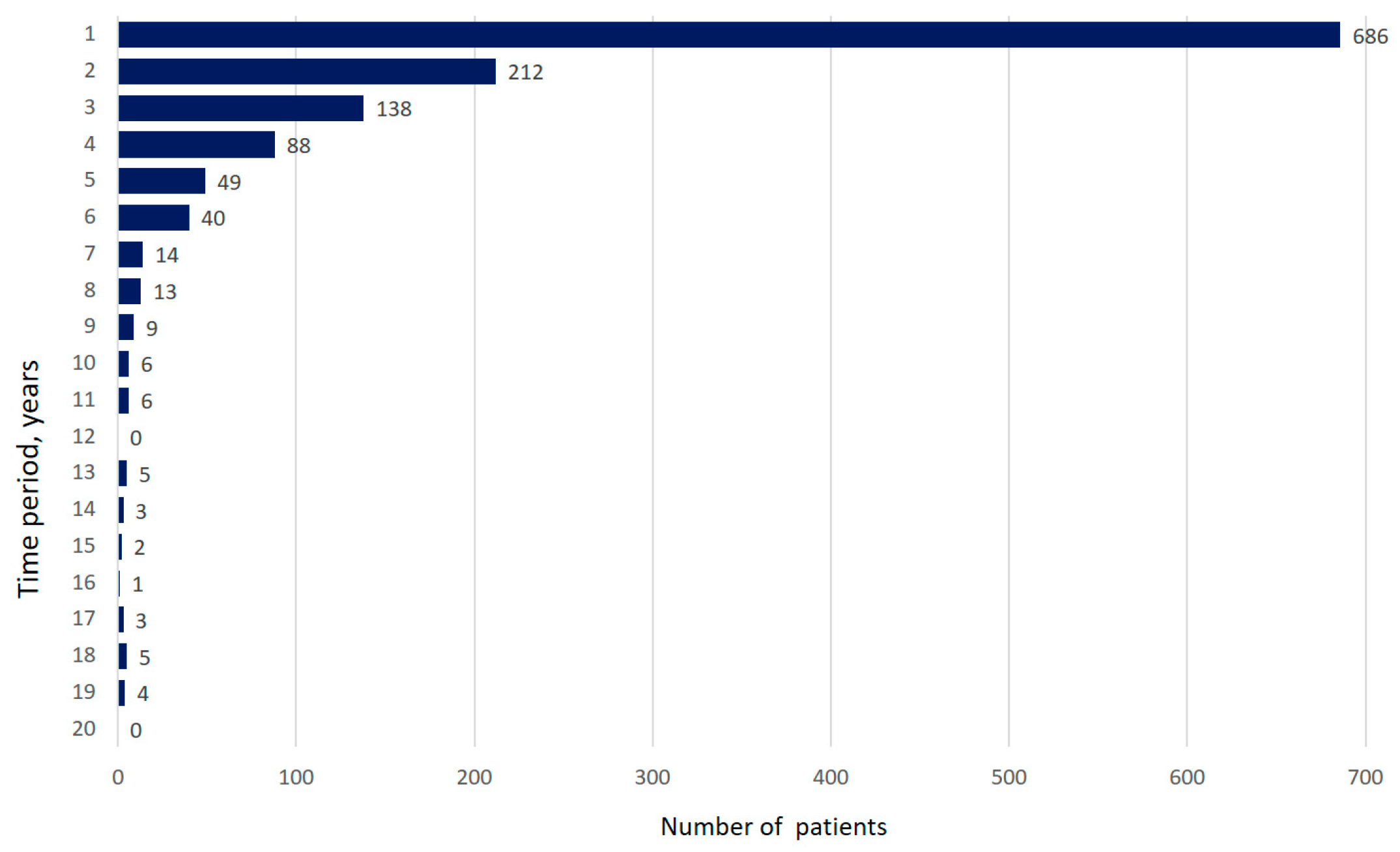
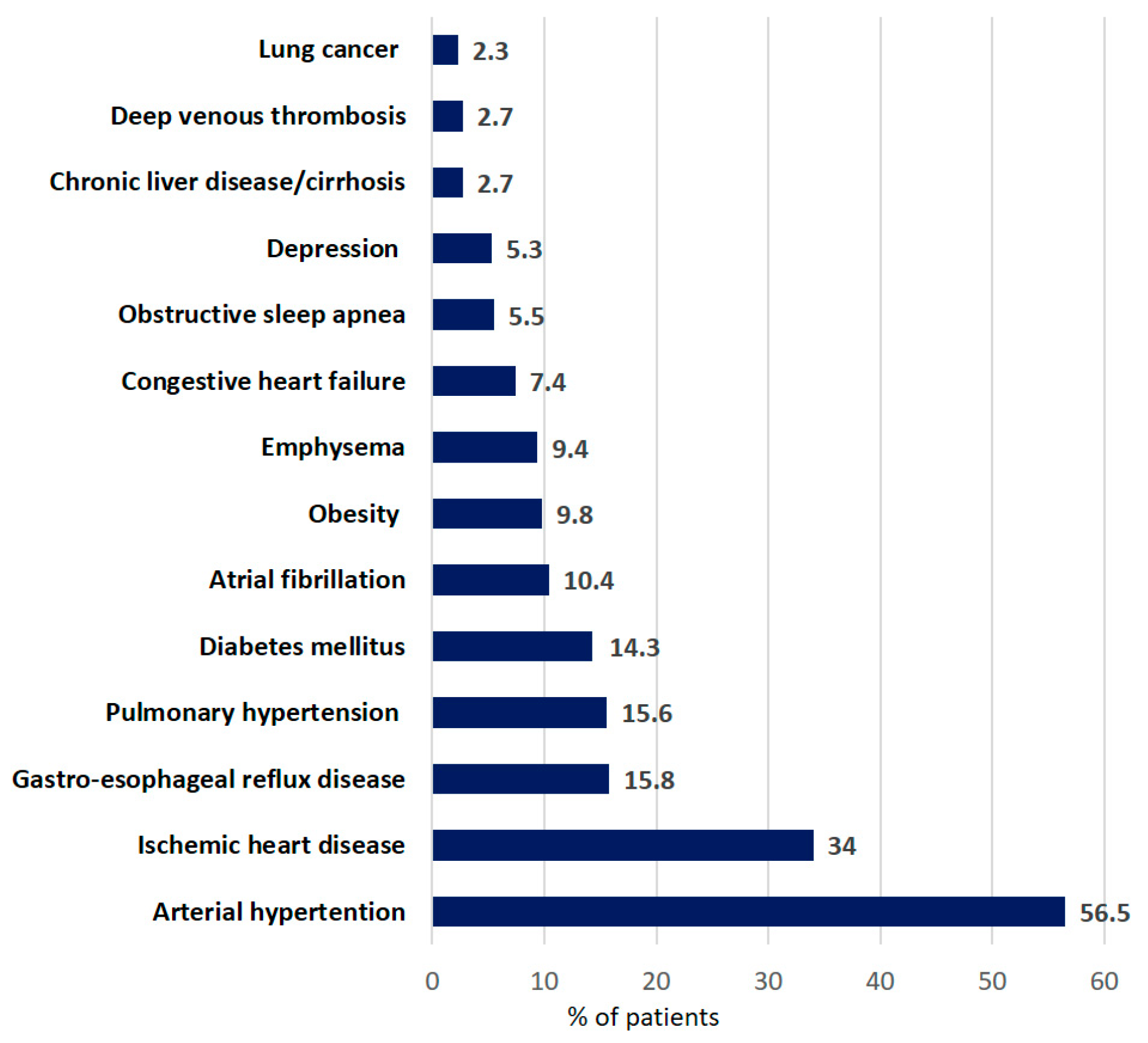

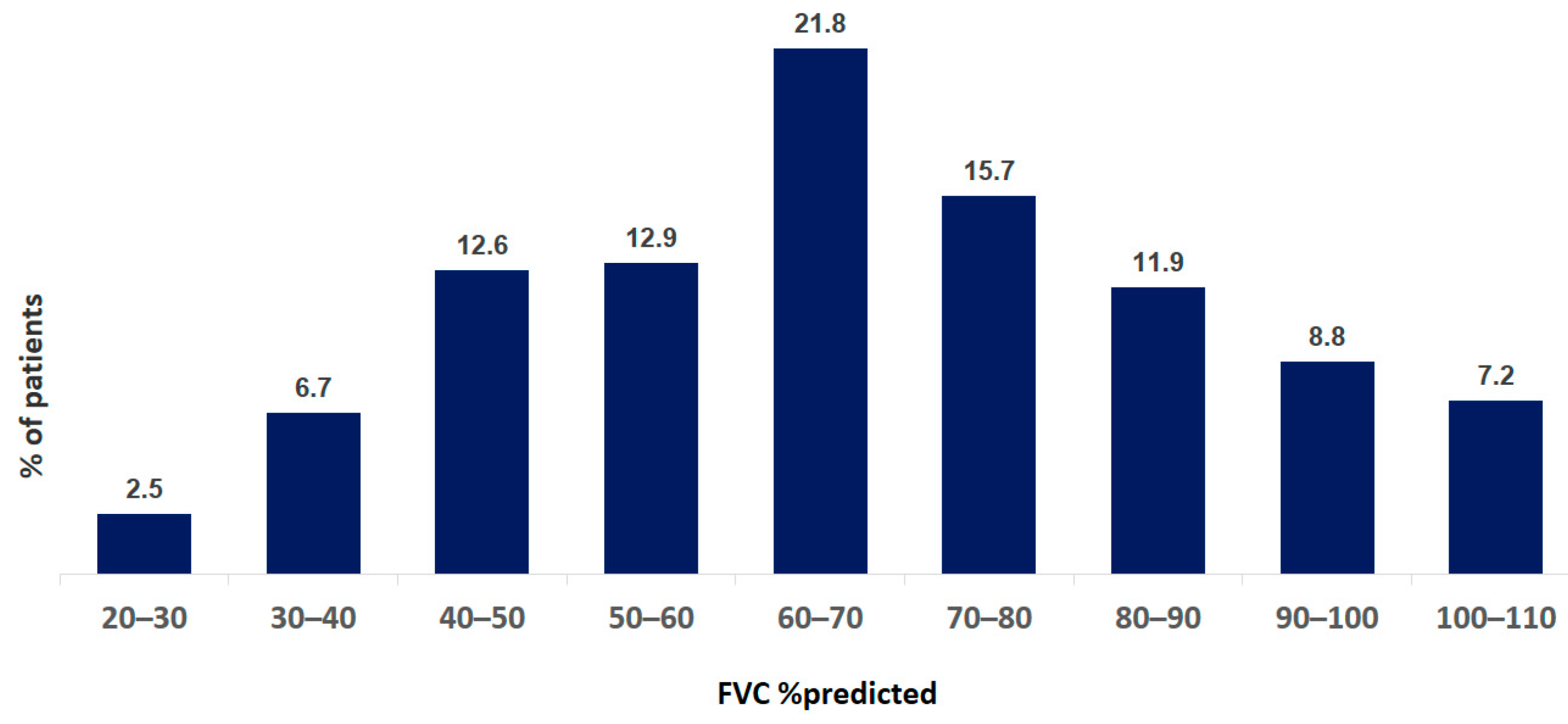
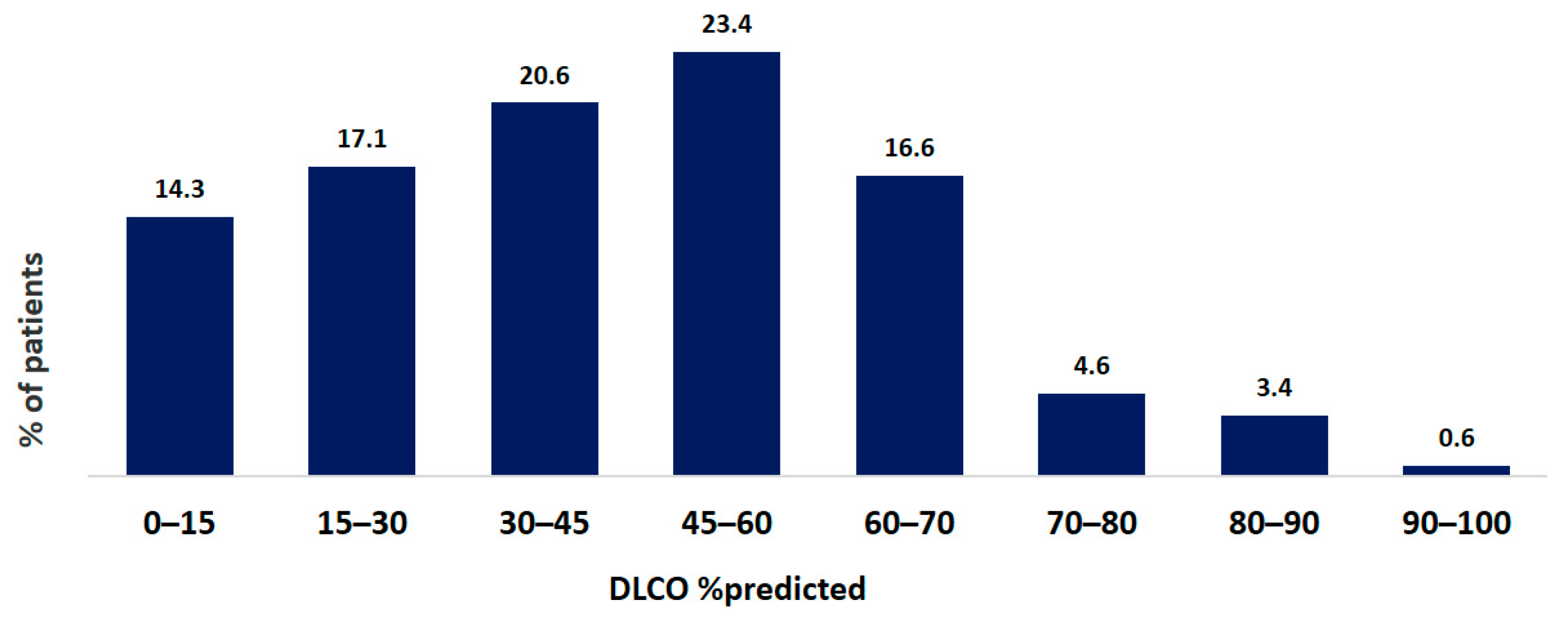
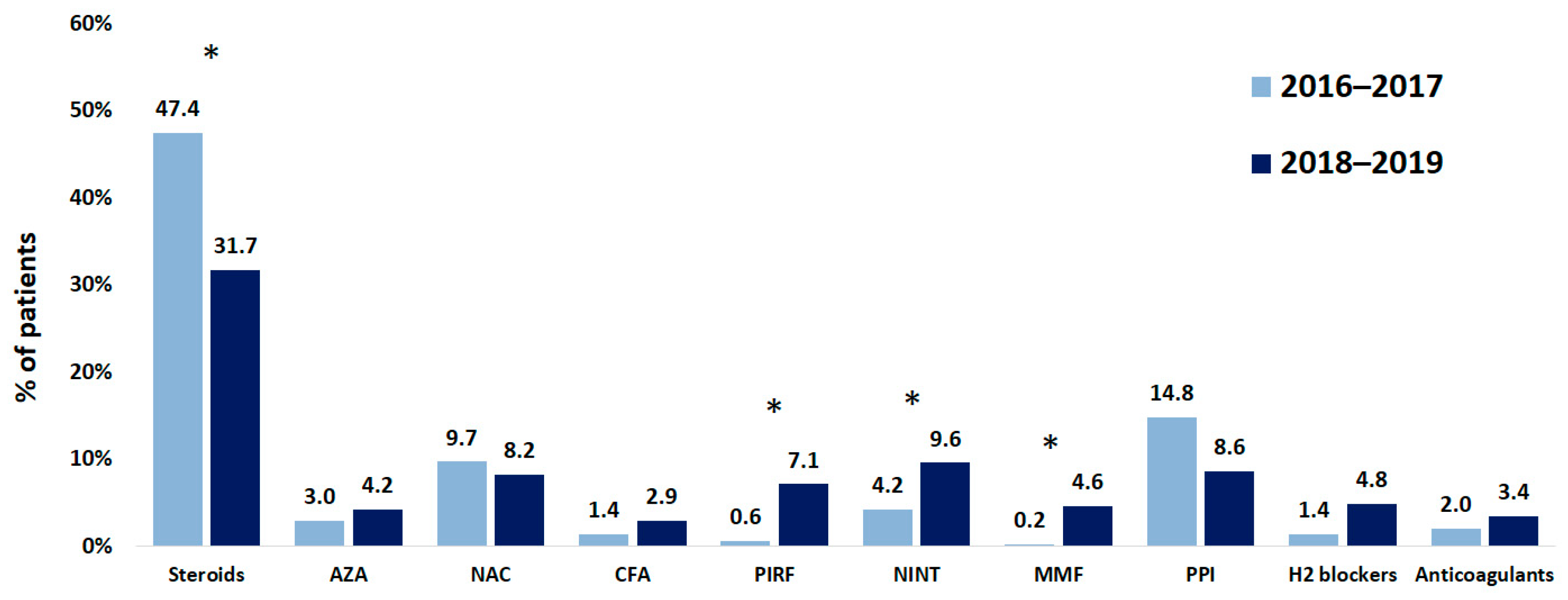
| Parameters | Patients with the LOD ≤ 6 Months | Patients with the LOD > 6 Months | p |
|---|---|---|---|
| Number of patients, n | 81 | 904 | |
| FVC, % pred. | 78.9 ± 23.7 | 69.3 ± 22.6 | 0.003 |
| FVC, L | 2.79 ± 1.08 | 2.36 ± 0.97 | 0.008 |
| FEV1, %pred. | 81.8 ± 21.9 | 72.8 ± 22.9 | 0.003 |
| FEV1, L | 2.31 ± 0.80 | 1.96 ± 0.73 | 0.003 |
| FEV1/FVC, % | 85.1 ± 8.7 | 84.7 ± 11.4 | 0.54 |
| TLC, %pred. | 74.6 ± 19.6 | 71.3 ± 18.6 | 0.32 |
| TLC, L | 4.79 ± 1.77 | 4.34 ± 1.40 | 0.24 |
| VC, %pred. | 84.3 ± 23.8 | 75.0 ± 21.0 | 0.06 |
| VC, L | 2.99 ± 1.13 | 2.62 ± 0.96 | 0.15 |
| DLCO, %pred. | 50.9 ± 16.5 | 46.9 ± 17.5 | 0.33 |
| DLCO/VA, %pred. | 75.8 ± 14.9 | 67.8 ± 18.4 | 0.13 |
| Russian Registry | INSIGHT-IPF [10] | SEPAR [17] | Australian IPF Registry [13] | PROOF [14] | IPF-PRO [18] | Finland IPF Registry [19] | EMPIRE (Czech Part) [11,16] | Latin American Registry of IPF [22] | Korea IPF Cohort Registry [23] | |
|---|---|---|---|---|---|---|---|---|---|---|
| A year of starting the registry | 2016 | 2012 | 2012 | 2012 | 2013 | 2014 | 2011 | 2012 | 2017 | 2008 |
| Patients’ age, years | 64.4 ± 10.7 | 68.7 ± 9.4 | 70.2 ± 9.2 | 70.9 ± 8.5 | 69.6 ± 8.6 | 70 (65–75) * | 73.0 ± 9.0 | 67 (50–82) # | 71.9 ± 8.3 | 67.4 ± 9.3 |
| Males/females, % | 42.5/57.5 | 77.9/22.1 | 80.8/19.2 | 67.7/32.3 | 76.9/23.1 | 74.9/25.1 | 65.1/34.9 | 70/30 | 74.7/25.3 | 76.1/23.9 |
| Active smokers, % | 12.6 | 1.7 | 9.0 | 71.7 | 6.5 | 68.4 | 7 | 53 | 2.4 | 12.9 |
| Ex-smokers, % | 44.7 | 60.4 | 63.7 | 66.8 | 48 | 52.3 | 58.1 | |||
| Never smoking, % | 42.7 | 38.0 | 27.3 | 28.3 | 26.7 | 31.6 | 45 | 47 | 45.3 | 29.0 |
| The length of disease before making the diagnosis | 19.8 ± 28.3 months | 46.9 ± 52.5 months | 20.4 ± 21.4 months | NA | 281 days | 14 (7–19) * months | 575 ± 799 days | 12 (2–48) # months | 12 (6–24) months | NA |
| FVC, % pred. | 69.7 ± 22.3 | 72.2± 20.6 | 77.6± 19.4 | 81.0± 21.7 | 80.6± 19.9 | 69.6 (60.1–9.95) * | 80.2± 18.2 | 80,0 (48.7–16.3) # | 70.9 ± 19.8 | 74.6 ± 17.5 |
| TLC, % pred. | 71.5 ± 18.8 | 70.2 ± 21.1 | 72.5 ± 16.5 | NA | NA | NA | NA | NA | NA | NA |
| DLco, % pred. | 46.2 ± 17.1 | 35.5 ± 15.5 | 48.5± 17.7 | 48.4± 16.7 | 46.9± 13.8 | 41.7 (32.2–50.1) * | 55.6 ± 16.5 | 45.6 (21.3–72.3) # | 53.7 ± 45.4 | 63.6 ± 22.0 |
| 6-MWD, m | 305 ± 141 | 268 ± 200 | 423.5 ± 110.4 | 420 ± 129 | 426.2 ± 130.8 | NA | NA | NA | 380.0 ± 135.8 | 399 ± 182 |
| HRCT, % | 97.8 | 90.2 | 99.2 | 93 | 97.5 | NA | NA | 100 | NA | ~100 |
| PFTs, % | 68.1 | 98.8 | 98.3 | 92 | NA | NA | NA | 100 | ~100 | |
| Lung biopsy, % | 16.2 | 34.1 | NA | 13 | 30.3 | 30 | NA | NA | 16.3 | 31.9 |
| Patients treated with SCS before entering the registry, % | 42.8 | 26.1 | 17.8 | 46 | 8.3 | NA | NA | 29.7 & | 4.2 | 13.7 |
| Patients treated with antifibrotics before entering the registry, % | 9.5 | 44.2 | 69.4 | 23 | 69.3 | 54 | 26 | 78 & | 72 | 34.1 |
Disclaimer/Publisher’s Note: The statements, opinions and data contained in all publications are solely those of the individual author(s) and contributor(s) and not of MDPI and/or the editor(s). MDPI and/or the editor(s) disclaim responsibility for any injury to people or property resulting from any ideas, methods, instructions or products referred to in the content. |
© 2023 by the authors. Licensee MDPI, Basel, Switzerland. This article is an open access article distributed under the terms and conditions of the Creative Commons Attribution (CC BY) license (https://creativecommons.org/licenses/by/4.0/).
Share and Cite
Chikina, S.; Cherniak, A.; Merzhoeva, Z.; Tyurin, I.; Trushenko, N.; Proshkina, A.; Ataman, K.; Avdeev, S. Russian Registry of Idiopathic Pulmonary Fibrosis: Clinical Features, Treatment Management, and Outcomes. Life 2023, 13, 435. https://doi.org/10.3390/life13020435
Chikina S, Cherniak A, Merzhoeva Z, Tyurin I, Trushenko N, Proshkina A, Ataman K, Avdeev S. Russian Registry of Idiopathic Pulmonary Fibrosis: Clinical Features, Treatment Management, and Outcomes. Life. 2023; 13(2):435. https://doi.org/10.3390/life13020435
Chicago/Turabian StyleChikina, Svetlana, Alexander Cherniak, Zamira Merzhoeva, Igor Tyurin, Natalia Trushenko, Anna Proshkina, Kirill Ataman, and Sergey Avdeev. 2023. "Russian Registry of Idiopathic Pulmonary Fibrosis: Clinical Features, Treatment Management, and Outcomes" Life 13, no. 2: 435. https://doi.org/10.3390/life13020435
APA StyleChikina, S., Cherniak, A., Merzhoeva, Z., Tyurin, I., Trushenko, N., Proshkina, A., Ataman, K., & Avdeev, S. (2023). Russian Registry of Idiopathic Pulmonary Fibrosis: Clinical Features, Treatment Management, and Outcomes. Life, 13(2), 435. https://doi.org/10.3390/life13020435






